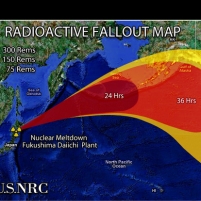Fukushima Radioactive Fallout Much Worse than Previously Reported
Saturday, October 29, 2011
 (graphic: Nuclear Regulatory Commission)
(graphic: Nuclear Regulatory Commission)
The nuclear power plant in Japan crippled by a powerful earthquake and tsunami on March 11, released nearly twice as much radiation as the government claimed.
Researchers at the Norwegian Institute for Air Research examined dozens of radiation monitoring stations throughout Japan and across the world and concluded that the amount of the primary contaminant, cesium-137 (an isotope with a 30-year half-life), that escaped into the atmosphere was about double the quantity estimated by Japanese officials.
The experts also reported that, despite what the Japanese government has claimed, the spent fuel rods stored at the Fukushima Daiichi plant contributed to the radiation release and that this added trouble could have been mitigated by a faster flooding of the pool that contained the fuel rods.
The report blames the unnaturally low Japanese estimate on the fact that Japanese scientists only measured radiation inside Japan. Only about 20% of the total fallout landed over Japan. Most of the rest fell over the Pacific Ocean, and some drifted all the way to North America and Europe.
Even though clouds of radioactive cesium-137 passed over Tokyo, the city was saved from serious contamination because the weather was dry and the clouds swept by without the cesium-137 falling on densely populated regions.
-Noel Brinkerhoff, David Wallechinsky
Fallout Forensics Hike Radiation Toll (by Geoff Brumfiel, Nature News)
Fukushima Fallout Was Almost Twice as Bad as Official Estimates, New Study Says (by Rebecca Boyle, Popular Science)
Xenon-133 and caesium-137 releases into the atmosphere from the Fukushima Dai-ichi nuclear power plant: determination of the source term, atmospheric dispersion, and deposition (by A. Stohl, P. Seibert, G. Wotawa, D. Arnold, J. F. Burkhart, S. Eckhardt, C. Tapia, A. Vargas, and T. J. Yasunari, Atmospheric Chemistry and Physics Discussions) (pdf)
Fukushima Radiation Level Hits Record High (by Noel Brinkerhoff, AllGov)
- Top Stories
- Unusual News
- Where is the Money Going?
- Controversies
- U.S. and the World
- Appointments and Resignations
- Latest News
- Musk and Trump Fire Members of Congress
- Trump Calls for Violent Street Demonstrations Against Himself
- Trump Changes Name of Republican Party
- The 2024 Election By the Numbers
- Bashar al-Assad—The Fall of a Rabid AntiSemite






Comments